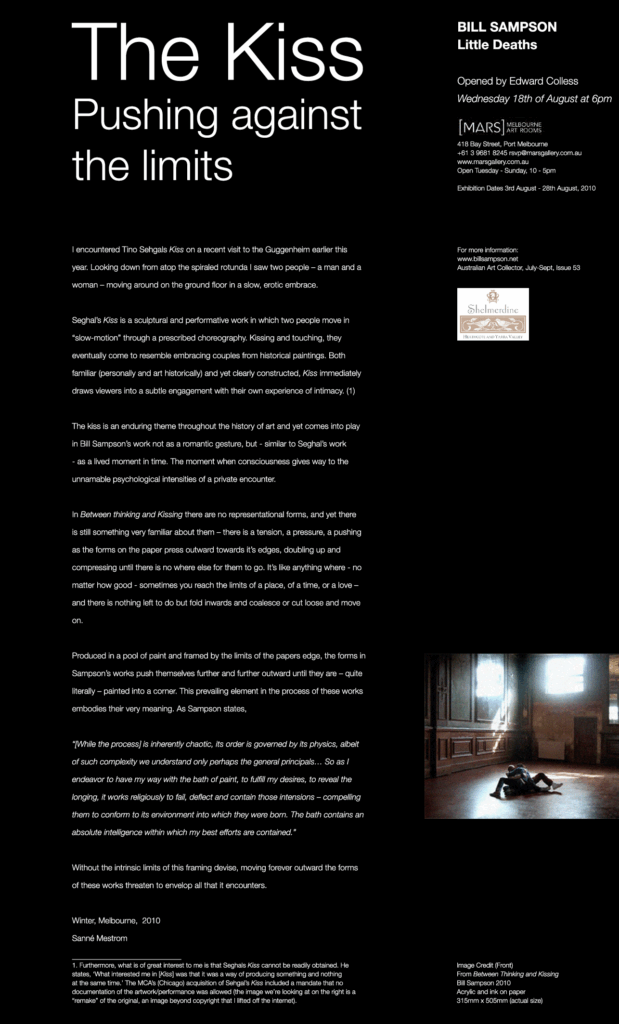Reproduction Mutation Selection Exhibition, 2015
Bill Sampson’s paintings and sculptures are more concerned with the act of perception than any narrative within the work itself. Moving away from his usual abstract work, Reproduction Mutation Selection comprises pairs of paintings and sculptures, the former recalling Dutch still life paintings of flowers against dark grounds, the latter amorphous resin forms that force our perception into the third dimension.
RAVEN - https://www.ravencontemporary.com.au/this-week-in-sydney-10-march-2015/
Bill Sampson’s works appear to hover in a state of flux between figuration and abstraction, providing the viewer with an uncanny, unexpected interaction. His works exude energy and life and in each piece one senses the artist’s physical application, as well as the personae of the media and materials used, offering an experience of colour and form that charges the senses.
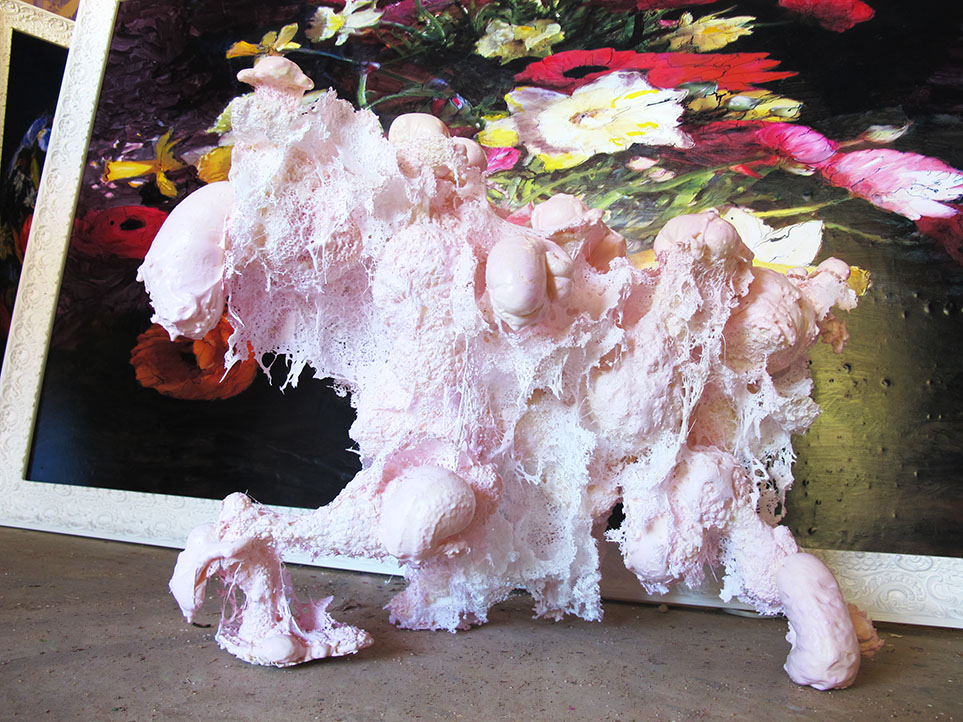
Reflections on Bill Sampson’s ‘Forces of Nature’ Exhibition
Counihan Gallery, Brunswick, October – November 2013
In this Exhibition, Sampson continues his Taoist way of questioning the character of the natural world. His respect for the ‘Way’ is shown by the form of his questioning. He does not interpose his ego, demanding that the Great Way flow and respond within the rigid rectangular boundaries that often frames Western thought. He has allowed the black and white thinking in the earlier stages of this work to be pressed back to the periphery by the pink of new beginnings. This is the very colour of new flesh that forms under the scab of a wound. In Bill’s case the ‘scab’ seems to be the lumps of paint that have to be washed off in order to discover the new being. In Bill’s gentle testing of the power of the new being, it is tempting to think in our combative, Western way that the rigid forms he placed in the matrix were torn apart. But that is not the Taoist way. These imposed structures on the natural harmony were gently put in their place, and the supposed demonstration of chance and chaos transformed into a particular manifestation of the Great Way.
Sid Forsey, 2013
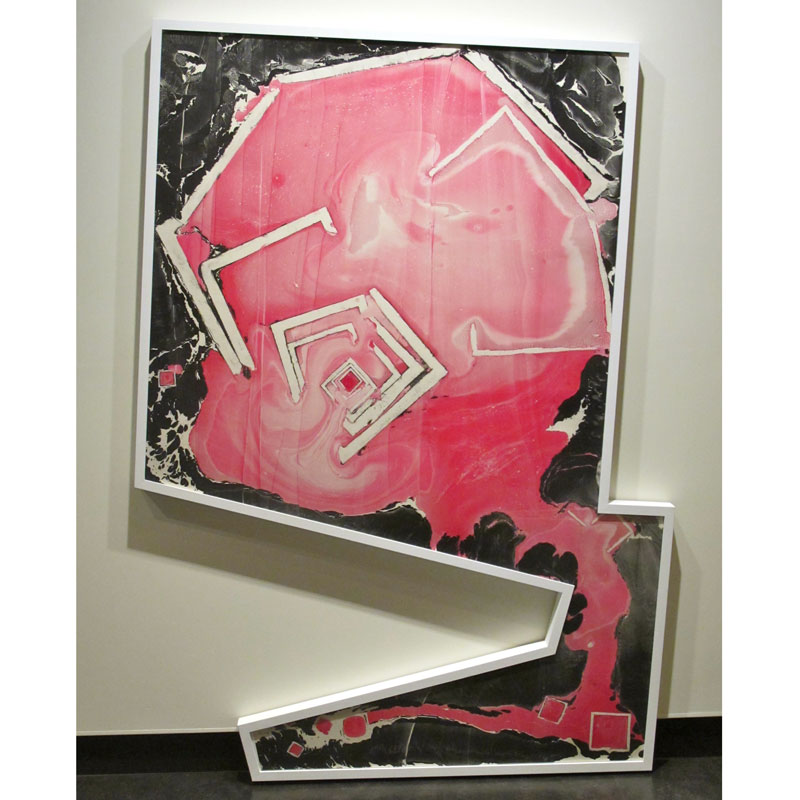
Battani’s place – a place, a home, a rupture
Curatorial Statement by ALEX PANELLI, descendant of Luigi & Serafini Battaini, resides at ‘Battani’s Place’, Tara Dale
The name Battaini, a variant Battaglini, is a diminutive of Battaglia, which in Italian means battle
In 1855, less than 20 years after Mitchell (the first white man) crossed this country, Luigi Battaini, a follower of Garibaldi in the unsuccessful 1848/49 campaign to unify Italy, and separately, Serafina Udini, 17 years of age and travelling with her father, found themselves amongst an unprecedented movement of people from Lombardy in Italy and Ticino in Switzerland, to the goldfields of central Victoria. A silence follows – a time from which no words have carried through to their descendants.
In 1862 this ends. Luigi and Serafina marry. They kept (and I still have) the certificate that shows it. They have a child. In 1863 a “Certificate of Naturalisation” is granted and in the same year another child (my great grandmother) is born. Within a few more years: two more children, and a license is issued “to reside on and to cultivate” a “parcel of Crown Land”. And a house is built.
Houses are built. Places are transformed and the past, it would seem, is erased. But before building there is thought, and before thought there is something else; we do not start with thinking. There was a house. I remember. I was carried. Within its walls I slept; I woke to morning. But the thing, a ruin now, is all but gone – and I must face it.
A house is made of parts and their arrangement: solids, openings, rigidities and foldings; with the total thing dependent on a place. But a house is more: it is not formed by place, but arises from and seems to hold a dream. We enter houses. We enter respectfully, for we have dreamed this dream. But the thing dissolves or floats; it does not hold. Yet we believe. Houses are homes for us. Homes are where people come from, and we know well, it’s people that are important. People go out from homes into the world, from where if all is well they should return. Or else they build new houses.
But, what if it’s not like that? What if we (in the steps of our ancestors) come to something that confuses, and there we dream. And then, though we awake, the dream still lingers?
Our houses are intermediaries, having two sides; they stand for us, and yet also with place. Can they be true? Are our houses really for us? What might that mean? Should they help us be with place – on peaceful terms, and lasting? Or should they insulate us from a harsher truth, and help us in naivety to trust that we are quite at home when we are not? Ultimately, could a house yet hold for us what makes this land our own, or can it only ever echo and unfold?
With their thoughts, our ancestors brought residues of houses that arose in other places.They remembered. Growing home-sick, yet choosing not to return to the realms from which they came, they tried to build such houses. They had come to this land believing that they could take from nature and subdue it. They dreamed of gold and houses. The quest for the security that finding gold might bring, and the building of houses, are not such separate things.
What then should my attitude be to this house? This much is clear: the thing itself and the dream from which it came, was flawed and failing. Yet I have come from it and dreamed its dream. So should it be, and in what form, perpetuated?
I have asked three artists, Frank Veldze, Bill Sampson and Annabel Nowlan, each in their own way, to help me face this challenge.Alex Panelli
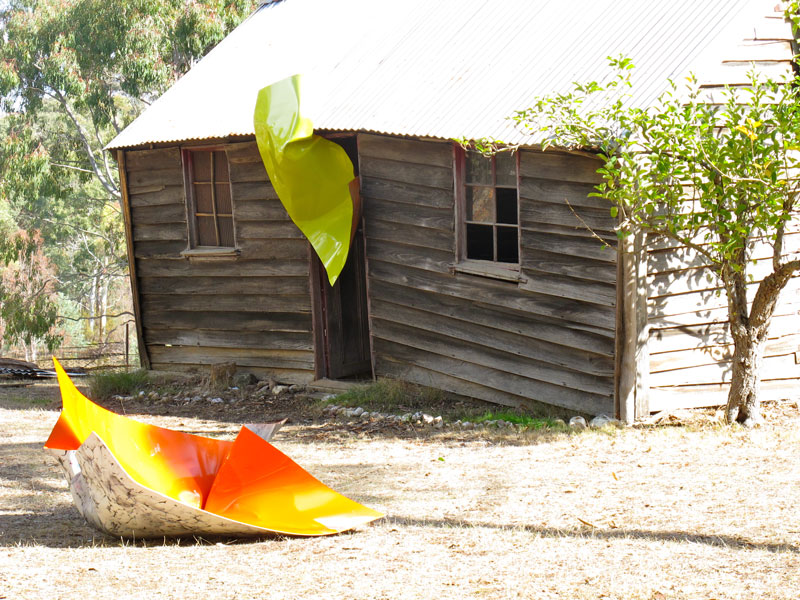
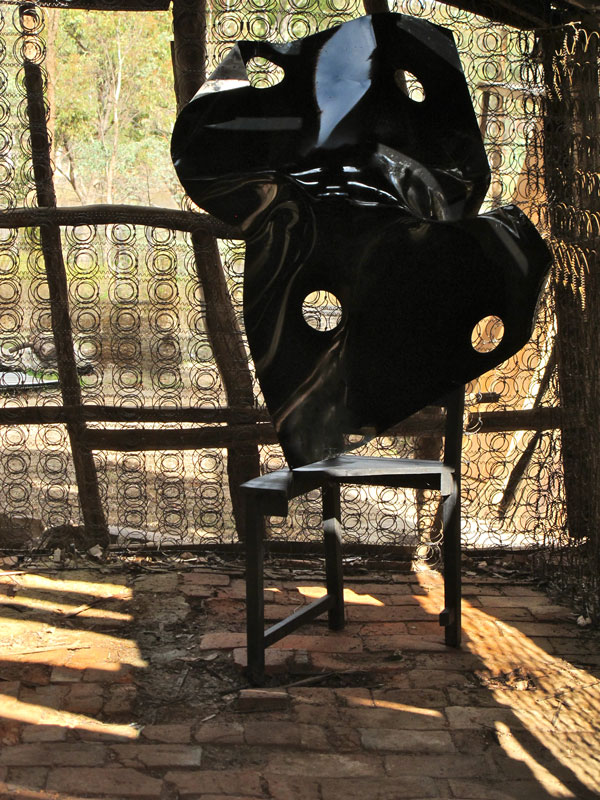
Chance Upon Nothing, Exhibition 2013
‘Dog Whistling’ Exhibition. Opening address by Emeritus Professor Richard Perry, 2013.
'Chemical Combat' by Dr. Sophie Knezic
Bill Sampson’s paintings – if we can call them that – are not contrived formal images, cadences of colour carefully orchestrated into iridescent compositions. Rather, they are paper-thin stage sets for liquid acts of ruin and destruction. Using and abusing a technique known as marbling, Sampson pours thin skeins of paint onto the skin-like surface of water then lets the paint take over, spooling in all directions with reckless assertion; little motors of churning colour. Part-impresario/part-artist, Sampson harnesses the invisible chemical constitution of paint to unleash its kinetic power. Coaxing unpredictable assaults between water, paper and paint, he subjugates artistic will to instead play addictive games of a different kind of chemical warfare. Adding stencils for masking, using bitumen, oil or acrylic, the artist spars with his materials. He flicks tiny balls of water onto the paper before placing it in the bath to create galactic splotches of white, drowns parts of the paper to allow the pigment to seep and curdle. Who would have thought that colour has actual acceleration? A literal force of propulsion specific to its hue? Indeed it does; the spectrum of paint is a series of individual profiles of mobile chemical agency. The act of marbling reveals the sheer brunt of the paint as it propels itself across the water’s meniscus, hotly fuelling its way until it hits an obstruction – pooling paint of another colour. Pink has the greatest puissance. Yellow is only just subordinate. Black is tractable; a push-over to fulgent colour’s chemical might. Annihilated by the high keys of colorant, black is sequestered into thin perimeters, shadowy residues around more powerful zones of pigment. The result of this chemical combat? A phantasmagoria of acidic colour and kaleidoscopic collisions. On parts of the paper, paint shrinks into sticky craters, elsewhere it stretches into bubblegum balloons. Paper stencils create white tectonic forms which, subjected to the action of the paint’s pressure, crack and tumble like shattering piano keys. There is fury here as well as torpor; a convergence of energy and inertia, coalescing as the chromatic legions reach their painterly détente, a final accord of visual blaze.Dr. Sophie Knezic, January 2013
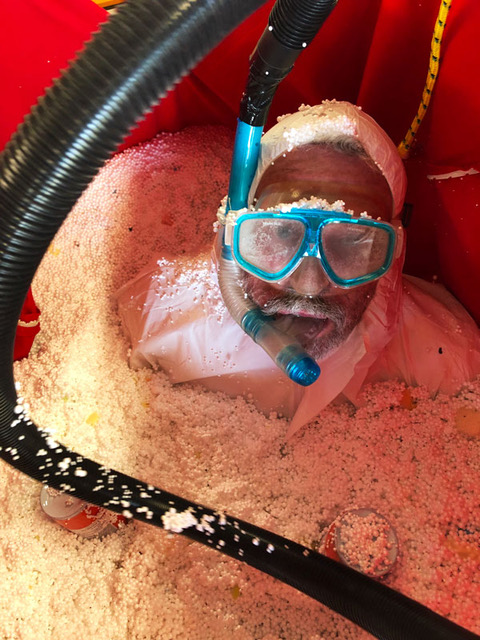
“Banging on about nothing” 2007
Marble is for monuments, such as arches and mausoleums, the great curve of the Empire's self-congratulatory triumphs, the towering dead. Marbling is for arrivistes now demanding more than just kiddy art, book decoration, plated gold taps. So! Behold the contorted nodules and fronds of monochrome alien landscapes! Behold the gas giants with their ever-shifting surfaces, garish ice blue rifts drifting and shattering in astral catastrophes!
Behold the lurid manifolds and their tears, nonexistent angels impregnating the labyrinths of absent ears with etiolated tongues, the soft pinks and peaches of reprised annunciations! Behold the sniffling beaks of decapitated parrots, the stripped pennants and ensigns of failed stellar armies, the slop and wobble of biomorphic teratologies, the pallid and silent throne of heaven, slick jaundiced mouths and mossy-green vulvas!
Oh the spatters, smears, freckles, globs, drips, squeaks, dips, swells, fat seamy veins of chocolaty horror, the crinkled spectres of not-so-fresh brains, the kitschy rip and crack of paper and bone! Suddenly become involutions of abyssal granite or sheer peaks of chrome, paper and plasterboard writhe with the bone-popping prettybadness of it all.
All over, endless, without centre or intent, the bastard child of innumerable tiny physico-chemical variables, Bill Sampson gives us soft-horror, cheesy sci-fi, disappointingly grainy porn, a kind of squishy generic implosion of degraded techniques, primitive and infantile, puerile and opportunistic.
Clement Greenberg wrote of the Abstract Expressionists that "their paintings startle because, to an uninitiated eye, they appear to rely so much on accident, whim, and haphazard effects." What Sampson has done, in return, is to detransubstantiate AE back into DIY. He has made it impossible to discern the differences between accident and design even with the beadiest of Greenbergian "initiated eyes."
No gaze can know enough to deal with these works. No gaze can know too little, either. No one can tell if these images are the results of talent or chance, or of incompetence or intent; no one can quite discern recognisable forms, yet no one cannot not anticipate the coming-to-form of these markings either, though such anticipations are never quite realised; no one can quite reconcile the images' appeal with their decorative or degenerate qualities.
A subtractive unexpressionist, Sampson revivifies anachronistic, degraded techniques, unhinges process and product, binds together incongruous names with disseminated images, assaults the knowing spectator, evacuates the artist, rips trace from trace from trace. The works themselves are indexical residues of an enormous number of little events, contextual, situational, linked causally to their process. But there is a gap, too: one cannot reconstruct the process from its residue, which it does not resemble in the slightest, and which cannot be repeated though every condition be repeated as carefully as possibly.
Time has changed, the atmospherics are different, every tub and tube of paint differs infinitesimally; the droplets run crazily hither and thither, bursting into malignant flower or pulsing organ or morphological anomaly. Minimal, imperceptible differences produce maximal visual disturbances. Nothing comes of nothing, as Bill Shakespeare puts it, but as far as Bill Sampson is concerned, nothing is still worth banging on about. Especially when it can look so great. Dr. Justin Clemens University of Melbourne May 2007Dr. Justin Clemens University of Melbourne, May 2007
Australian Art Collector
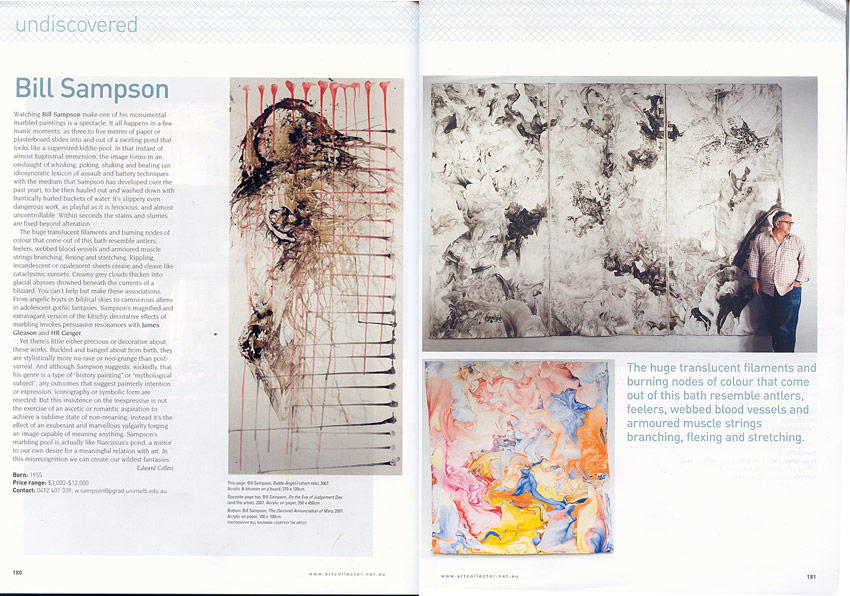
Australian Art Collector
‘Undiscovered’, April 2007, Dr Edward Colless
‘…as a viewer you can put abstract expressionism aside as the main reference point and see them as mind maps or as explorations of a hitherto unseen world. This could be a world of destruction, of an angry earth fighting for its very survival.’ David O’Halloran, artinfo.com.au 2007
David O’Halloran is an Australian visual art curator of 25 years experience working with some of the country’s most important visual arts organisations including the Biennale of Sydney, the Contemporary Art Centre of South Australia, Contemporary Art Services Tasmania, and the Adelaide Festival.
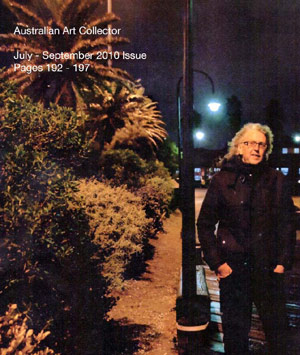
Australian Art Collector
July/September 2012, Dr Edward Colless
